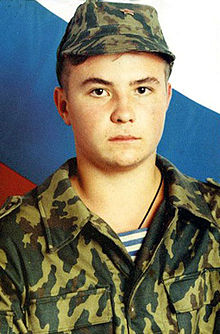Kaznj Russkih Soldat V Chechne Vikipediya

Donbass-i-CHechnya-Pochemu-nelzya-sravnivat-150x150.jpg, 27-Jul-2015 14:12. Russkiy---SHmel---priletel-v-Siriyu-150x150.jpg, 12-Nov-2015 14:58, 4.6K. Pochemu-Putin-protiv-smertnoy-kazni--150x150.jpg, 23-Nov-2015 14:35, 5.1K.

Russian soldier on skis wearing valenki boots Valenki stem from the traditional felt boots worn by nomads of the Great Steppe (including Southern ), whose history goes back over 1500 years. However, as it’s supposed, the boots appeared at the beginning of the 18th century. Valenki became widespread only in the first half of the 19th century, when they started being manufactured by industrial methods. Before this, they were quite expensive and only wealthy people could afford to have them. The increasing complexity of needs, the growing influence of the urban mores to the village caused the change of bast shoes with felt boots, and with it, the broad development of fulling production. Valenki became less popular in the urban life in recent decades because winters in turned to be more soft and slushy, and as result – lighter and waterproof footwear gradually won popularity and replaced valenki. Valenki are associated with a traditional rustic style of clothing; in cities they are usually worn by little kids, or they are worn by one and all in a severe, when other shoes don’t protect from the cold.
Before the, the production of valenki was concentrated in the Semenov district of province, in the District of, and in the in. In 1900, contemporary jackboot factories of Russia produced 1.4 million pairs of valenki in the amount of 2.1 million. In 1900, a pair of valenki cost 1.5 rubles, in 1912 - 2 rubles, at the end of 1916 the speculative price reached up to 12-18 rubles per pair. See also [ ] • • • References [ ].
Location within Republic of Dagestan The Tukhchar massacre was an incident during the, filmed and distributed on tape, in which Russian were executed. Throughout the war, Russian soldiers reported finding taped executions of Russian officers and men. Experts say such films were an attempt to frighten enemy soldiers and advertise their deeds.
Gm tech 2 software download free. Mastertech VCI Now Supports GM Tech2WIN Software GM's Tech2WIN provides a virtual environment to allow authentic GM Tech 2 diagnostic software to run on a PC running windows. Tech2WIN provides the following OEM functionality. Free Software Download GM Tech 2 PCMCIA bin file multi-language Posted on December 5, 2016 by Sales auto-diagnosis.org As we know,there are a lot of free software in car diag tool website. Tech2Win is the Tech2 emulator software for GM diagnostics. It allows you to use your J2534 pass thru as a Tech2 on GM vehicles. The following instructions will walk you through downloading and setting up Tech2Win. NOTE: If you already have Tech2Win installed and just renewed your subscription. Tech2Win 33.002 GDS2 v15.2 Tech 2 software download free May 3, 2017 sales Car diagnostic tool 0 Free download GM GDS2 crack V15.2 and Tech2Win 33.002 crack here! Tech2 software. 32MB for GM,OPEL,SAAB,ISUZU, Suzuki, Holden GM tech 2 card GM TECH2 CARD Includes a 32MB PC Card loaded with the latest release GM Software.
Some videos were later sold as and ended up online. One tape created in September 1999 showed six Russian servicemen, one as young as 19, being brutally executed by Chechen terrorists.
The video, both in part and in whole, has been uploaded to various video streaming sites such as, where it is also known as the Dagestan beheadings. English-language sites often contain misinformation about the event, including the names of the soldiers, the name of the Chechen commander, and the year. As a result, the event has been mistakenly identified as the of four Russian soldiers at the end of the. Ljubavni romani pdf scribd account. Contents • • • • • • • • • • • Battle [ ] On 5 September 1999, two units of Chechen militants crossed into, seizing the border village of Tukhchar in the. The Chechen commander leading the attack was identified as Umar Edilsultanov (known as Karpinsky Amir, named after the microdistrict of Karpinka in ), a subordinate of Abdul-Malik Mezhidov, commander of the of. Attacking very early in the morning, the Chechens found and exchanged fire with 12 Russian conscripts and one officer of the brigade stationed at a police checkpoint to strengthen border security.
Shortly after the fighting began, the Russian operator of the unit's 30 mm was killed, communication was disrupted, and the Russians had run out of ammunition. Vasily Tashkin ordered a retreat to a second checkpoint. During a lull in the battle, local residents told Russian soldiers that the Chechens had given them half an hour to leave the village. The villagers brought with them civilian clothing so they could smuggle the policemen and soldiers out of town safely. Tashkin refused to retreat any further, and his resolve convinced others to stay as well.
When the half hour was up, the Chechen militants began to search for the Russian defenders, who had been hidden by the townspeople. Six of them barricaded themselves in a barn, but the Chechens surrounded it and poured gasoline on the walls, threatening to burn the structure down. The Chechen militants called for the Russians to surrender, claiming that their intent was to obtain leverage for a.
Massacre [ ] The six gave up their arms and surrendered on the promise of becoming prisoners of war. It was not long before the Russians realized that they had been deceived.
In the name of resolving a '—revenge for the recent loss of four friends and relatives in the war—the Chechen commander Umar Edilsultanov then staged a in a nearby field. The prisoners were ordered to lie face down on a track outside the village, and Edilsultanov selected five men from his unit to behead the prisoners. The sixth (Alexey Polagaev) was killed by Edilsultanov himself.